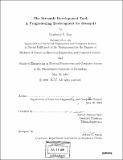The StreamIt development tool : a programming environment for StreamIt
Author(s)
Kuo, Kimberly Sue, 1981-
DownloadFull printable version (17.05Mb)
Alternative title
SDT : a programming environment for StreamIt
Other Contributors
Massachusetts Institute of Technology. Dept. of Electrical Engineering and Computer Science.
Advisor
Saman Amarasinghe.
Terms of use
Metadata
Show full item recordAbstract
StreamIt [28] is a high-level programming language intended for the development of large-scale and high-performance streaming applications that are characterized by the processing of data streams by modular structures. The StreamIt Development Tool (SDT) [25] is designed to aid the coding and simultaneous code- and graph-based debugging and visualizing of programs written in StreamIt. The goal is to provide a graphical programming environment that simply and intuitively conveys the hierarchical and structured nature of the StreamIt language by visually interpreting the dynamic behavior and graph representation of a StreamIt application. Consequently, the SDT provides utilities for program creation and code editing, compilation and launch support, breakpoints and code stepping, general debugging infrastructure, help support, stream graph examination and navigation, and stream data display, modification, and tracking. A user study evaluating the SDT uncovered several problems and areas of improvement that need to be addressed before this tool can approach its goals. Assessment of the SDT's efficacy in its current state is inconclusive--the SDT demonstrates both the ability to improve and hinder a user's debugging ability. Facilitating effective coding and debugging techniques and developing for scalability are critical elements in improving the SDT's effectiveness.
Description
Thesis (M. Eng. and S.B.)--Massachusetts Institute of Technology, Dept. of Electrical Engineering and Computer Science, 2004. Includes bibliographical references (leaves 127-130).
Date issued
2004Department
Massachusetts Institute of Technology. Department of Electrical Engineering and Computer SciencePublisher
Massachusetts Institute of Technology
Keywords
Electrical Engineering and Computer Science.